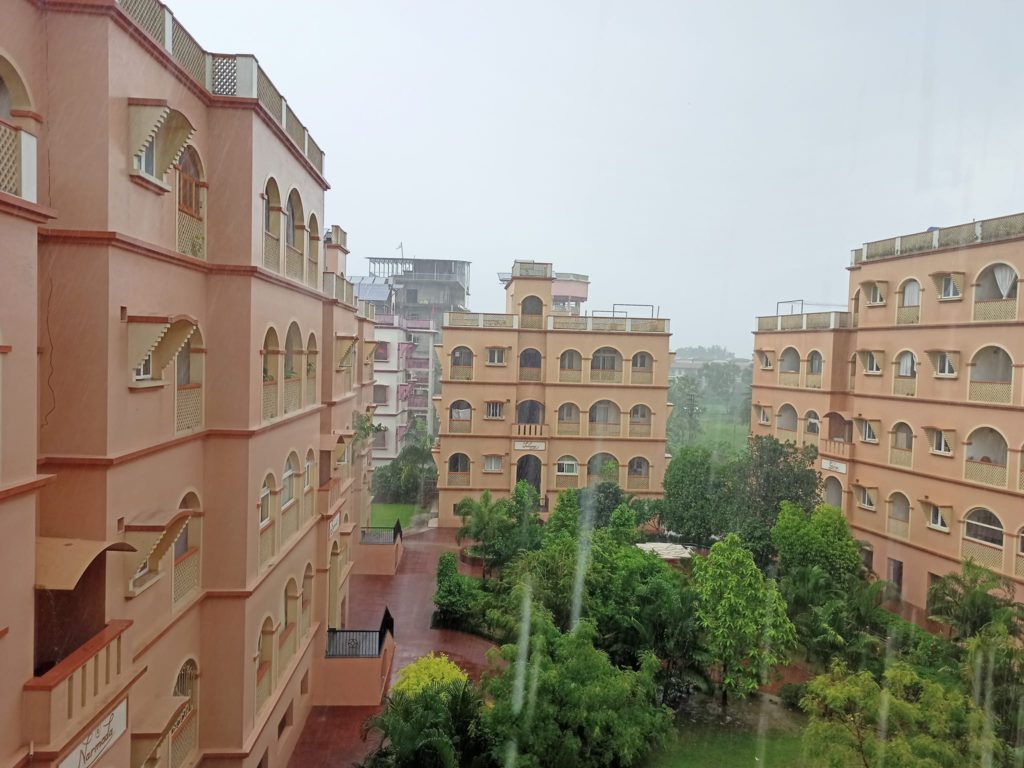July, August, and September is the period of rain in Mayapur. That’s the period of the monsoons, included in the four months of Caturmasya. When we speak about “monsoons”, some apocalyptic image comes to mind, but it is not as bad as it may seem. Nothing terrible happens, it just rains more.

Usually, there is strong heat in the months of April, May, and June, when temperatures can reach 45 degrees or more in the hottest period of the day. However, it is not as bad as it may seem, because these high temperatures are just in the hottest part of the day. During the morning and evening, the temperature drops to around 30 degrees. Most devotees just change their routines to do things at these times, staying at home during the hottest hours.
At the end of the hot season, there is a short storm period, of two weeks or so, when there are very strong (but usually short) rains in the afternoon. Around this time the temperatures stabilize at around 30 to 35 degrees, but the humidity increases.
Now we are in the period of rain, which usually goes until September. During this time we have regular rains that can last for several hours and many overcast days. There may be some difficulties with mud on the smaller roads, and the electricity is cut more frequently, but nothing excessive. Just like in the hot season, an AC is very helpful during this period, because although the temperatures are much milder, there is a lot of humidity, something an AC helps to solve. A UPS with a big tubular battery is also very advisable to deal with frequent power cuts. The UPS keeps the fans, WiFi, and lights running (out can put some outlets on it also), so one can concentrate on what he is doing instead of on the electricity coming and going. In most houses, the electric installation is already prepared, one has just to buy it. It costs around 20,000 rupees (for the UPS plus battery), but I believe it is a good investment since it lasts about 5 years.
This is also the period when there can be floods. Nowadays there are several dams up into the river that prevent floods on most years. Now there are floods only when the rains are well above average. Before there used to be floods every 3 or 4 years, but now they are very sporadic. The last flood we had in Mayapur was in 2015. Most buildings are built with the first floor above the flood level. The water, electricity, and internet also usually continue working and most roads (that are also built above the flood level) remain open, although you may have to swim to reach the road. The main problem during floods is that a lot of people from villages, as well as devotees who live in houses at ground level become homeless and there is a need for a lot of assistance. Devotees always donate everything they can and there is a lot of opportunity for service.
Many devotees who live in Mayapur travel during this time, visiting their countries, preaching, or working outside, but if one one wants to stay in Mayapur it’s perfectly fine. This time of the year is very good for staying in peace practicing sadhana, chanting, going to the temple, etc. The atmosphere becomes very conducive for study and introspection. We can see that historically people would reserve these rainy months to settle down in one place and focus on their spiritual practice. It’s not a coincidence.
If one is visiting, another advantage of this period is that becomes much easier (and cheaper) to find apartments, since the demand collapses and many devotees leave. In this sense is the opposite of Kartika and Gaura Purnima, when everything becomes expensive. If you are on a budget, this is a period to consider.
After that, we will enter into the pleasant period of the year, which includes Kartika and Gaura Purnima. This is the period when many visitors come to Mayapur and there are a lot of things going on.
